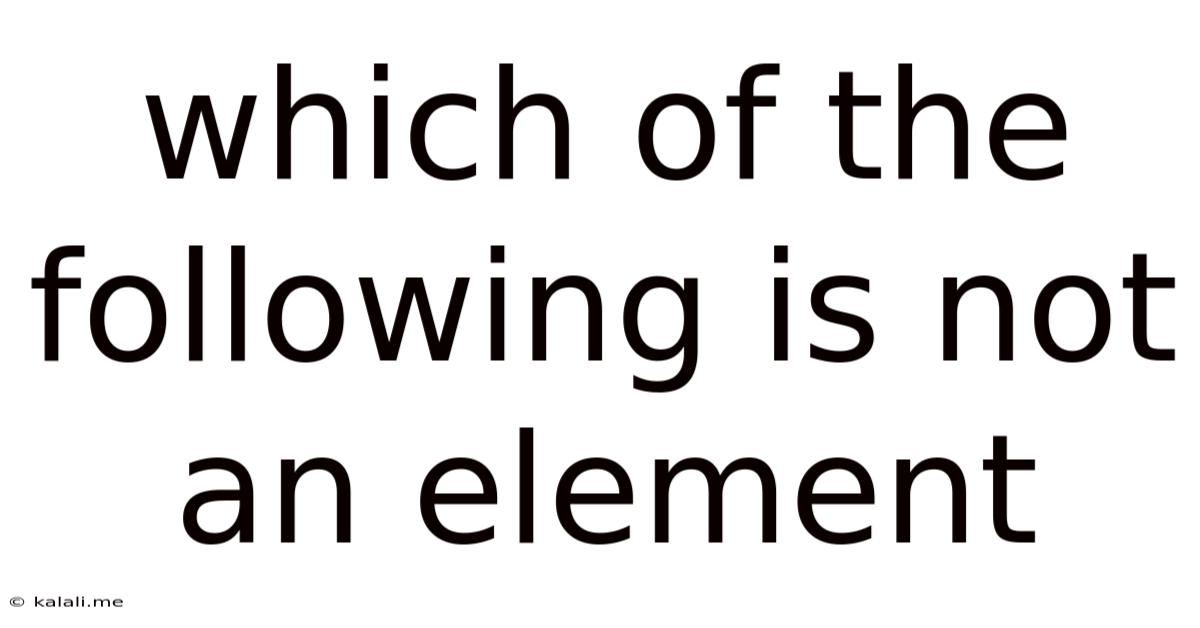Which Of The Following Is Not An Element
Kalali
Jun 11, 2025 · 3 min read

Table of Contents
Which of the Following is Not an Element? Understanding Elements, Compounds, and Mixtures
This article explores the fundamental difference between elements, compounds, and mixtures, ultimately answering the question: which of the following is not an element? We'll delve into the characteristics of each, providing clear examples to solidify your understanding of matter at a fundamental level. Understanding this distinction is crucial for anyone studying chemistry or related sciences.
What is an Element?
An element is a pure substance consisting only of atoms that all have the same number of protons in their atomic nuclei. This number is known as the atomic number and uniquely identifies each element. Elements are the fundamental building blocks of all matter. They cannot be broken down into simpler substances by chemical means. Think of them as the basic ingredients in the "recipe" of the universe. Examples include hydrogen (H), oxygen (O), iron (Fe), and gold (Au). The periodic table organizes and displays all known elements.
What is a Compound?
Unlike elements, compounds are pure substances formed when two or more different elements chemically combine in a fixed ratio. This combination involves the sharing or transfer of electrons, forming chemical bonds. The properties of a compound are distinctly different from the properties of its constituent elements. For instance, water (H₂O) is a compound formed from hydrogen and oxygen; it's a liquid at room temperature, unlike its gaseous components. Other examples include table salt (NaCl), carbon dioxide (CO₂), and glucose (C₆H₁₂O₆). Compounds can be broken down into simpler substances (their constituent elements) through chemical reactions.
What is a Mixture?
A mixture is a combination of two or more substances (elements, compounds, or both) that are not chemically bonded. The components of a mixture retain their individual properties, and their proportions can vary. Mixtures can be homogeneous (uniform throughout, like saltwater) or heterogeneous (non-uniform, like sand and water). Crucially, mixtures can be separated into their components by physical methods, like filtration, distillation, or evaporation. Air, soil, and many everyday materials are examples of mixtures.
Identifying Non-Elements: A Practical Approach
To determine whether something is not an element, look for evidence of chemical bonding or the presence of multiple types of atoms. If a substance can be broken down into simpler substances through chemical reactions, it is not an element. If the substance is a combination of different types of atoms with varying ratios, it is likely a compound or a mixture.
Examples:
Let's consider a few examples to illustrate the concept. Suppose you are given a list:
- Water (H₂O): This is a compound, not an element, because it's formed from hydrogen and oxygen atoms chemically bonded together.
- Iron (Fe): This is an element. It consists only of iron atoms.
- Air: This is a mixture of various gases, including nitrogen, oxygen, and argon.
- Salt (NaCl): This is a compound, composed of sodium and chlorine atoms.
- Sugar (C₁₂H₂₂O₁₁): This is a compound, a carbohydrate made of carbon, hydrogen, and oxygen.
Conclusion:
In summary, any substance that is not composed solely of one type of atom is not an element. Compounds and mixtures are both examples of substances that are not elements. Understanding the differences between elements, compounds, and mixtures is fundamental to comprehending the nature of matter and the world around us. By learning to identify the key characteristics of each, you will be able to confidently determine which of a given list is not an element.
Latest Posts
Latest Posts
-
How Much Does A Gallon Oil Weigh
Jul 01, 2025
-
How Many Crackers In A Sleeve Of Saltines
Jul 01, 2025
-
How Many Years Are In 48 Months
Jul 01, 2025
-
What Grade Is A 12 Out Of 15
Jul 01, 2025
-
The Opposite Of The Opposite Of Inexact Is
Jul 01, 2025
Related Post
Thank you for visiting our website which covers about Which Of The Following Is Not An Element . We hope the information provided has been useful to you. Feel free to contact us if you have any questions or need further assistance. See you next time and don't miss to bookmark.